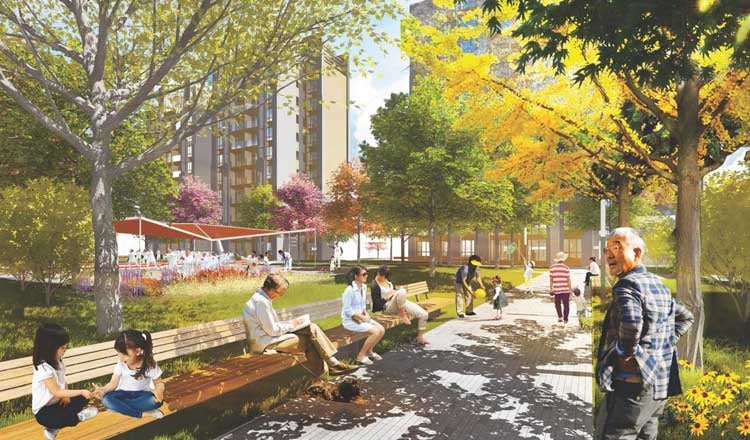
Ending Global Sprawl: Create Human-Scale Streets and Small Blocks
This article was originally published in Ending Global Sprawl: Urban Standards for Sustainable and Resilient Development, written by Peter Calthorpe and published by the World Bank's Global Platform for Sustainable Cities. Ending Global Sprawl explores forward-thinking planning strategies for the urban form.
Principle 6: Create Human-Scale Streets and Small Blocks
Increase density of road networks with small blocks and human-scaled streets.
Rationale and Challenges
Human-scale streets and small blocks are the essential elements of an effective urban transportation network and human-scaled neighbourhoods. They create a dense mesh of narrower streets and paths that are more intrinsically pedestrian-friendly, helping shift people away from automobile use and thus improving air quality. At the same time, they can help optimize the flow of traffic for remaining cars by creating dispersed, parallel routes. Small blocks also allow a greater variety of public spaces, architecture, and activities, thus increasing the neighbourhood's vibrancy.
In new high-rise areas, superblocks have been a dominant planning paradigm due to the convenience it affords construction, parking, and infrastructure. Ironically, the large arterial streets that result from superblock development constrict auto flow compared to a denser network of smaller streets. With superblocks, all traffic is concentrated on a few main avenues with large and slow intersections. The net result is traffic congestion and barriers to pedestrian and bike movement, thus encouraging more people to drive.
The concept of small blocks and human-scaled streets is not an innovative idea. In fact, they are common features of cities around the world built prior to WWII. The legacy of these older urban forms is still prominent in central cities today, not only contributing to the diversity of cityscape but also providing a possibility to explore and contrast impacts of urban form on household travel behaviour and transportation energy use.

Goals and Actions
6A: Create human-scale blocks and streets
- ACTION 1: Develop blocks with perimeter buildings to provide shared interior courtyards and active sidewalks
- ACTION 2: Reshape existing superblocks and cul-de-sac subdivisions with pedestrian passages
6B: Disperse traffic over narrow, parallel routes with a grid of varied street types
- ACTION 3: Locate larger expressways and highways at the district edge
- ACTION 4: Limit major through street widths by substituting with one-way street couplets
6C: Establish car-free corridors that accommodate dedicated and connected biking and walking paths, which may include transit lanes
- ACTION 5: Auto-free streets should provide shopping and services at the building ground level
- ACTION 6: Connect auto-free streets to trails and paths within major open spaces
Metrics
6.1: Block Size
Ensure that at least 70% of blocks in residential areas are 1.5 hectares or less and commercial blocks in non-industrial areas are 3 hectares or less
6.2: Setbacks
Decrease setbacks to a maximum of 1 meter for retail, 3 meters for commercial, and 5 meters for residential
6.3: Street Size
No street should be more than 40 meters in non-industrial districts
6.4: Auto-Free Streets
Create auto-free streets for any combination of pedestrian, bike, or transit at an average spacing of 1 kilometre

Benefits
Economic
- Saves costs on infrastructure: Based on planning and development costs studies, a 30% reduction in roadway infrastructure costs is realized due to savings from pavement, curbs, drainage, streetlights, and trees for dense urban networks in contrast to superblocks.
- Decreases energy use: Small blocks contribute to energy savings due to less travel demand by supporting increased use of non-motorized travel modes and transit.
- Increases retail space: Small blocks create more sidewalks, which naturally means more retail space for developers to sell.
- Attracts talent: Small blocks lay the foundation for interesting, vibrant places, which in turn can attract diverse human talent to the local workforce.
- Increases flexibility in land development financing: Developments can be financed in smaller phases, meaning less capital must be raised at any given time.
Environmental
- Reduces energy used for travel: Superblock residents use more energy to satisfy their transportation needs compared to residents of other types of neighbourhoods.
- Reduces congestion: Small block urban networks decrease traffic delays by 25% because traffic flow is more efficient. For example, congestion and environmental damages have reduced Beijing’s economic output by 7.5% to 15% .
Social
- Increases driver accessibility and safety: Cities with small blocks are safer for drivers. A dense street network can also add resilience to the transportation system by providing many alternative routes for ambulances and fire trucks in emergencies.
- Increases pedestrian accessibility and safety: The elderly and children can more easily navigate areas with small blocks. A dense street network with short and frequent pedestrian crossings also greatly enhances pedestrian safety and reduce jaywalking.
- Enhances sense of community: Small residential blocks with more defined space shared by fewer residents create a suitable social scale where everyone knows each other, thus nurturing a sense of belonging for the community.
About the Author: Peter Calthorpe

Peter’s long and honoured career in urban design, planning and architecture began in 1976, combining his experience in each discipline to develop new approaches to urban revitalization, suburban growth and regional planning. In 1983, Peter founded the award-winning firm of Calthorpe Associates devoted to sustainable urban design and planning globally. In May 2019, Calthorpe Associates joined HDR. Throughout his career in urban design, planning and architecture, he has been a pioneer of innovative approaches to urban revitalization, community planning, and regional design. For his contribution in redefining the models of urban and suburban growth, he was awarded Urban Land Institute's prestigious J.C. Nichols Prize for Visionaries in Urban Development in 2006. He is one of the founders and the first board president of Congress for the New Urbanism. Metropolis Magazine claims: "The titles of Peter Calthorpe’s books define the recent history of urban design in its most vital and prescient manifestations."

